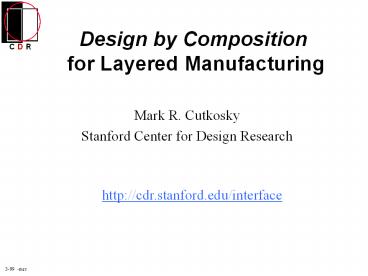Design by Composition for Layered Manufacturing PowerPoint PPT Presentation
Title: Design by Composition for Layered Manufacturing
1
Design by Composition for Layered Manufacturing
- Mark R. Cutkosky
- Stanford Center for Design Research
http//cdr.stanford.edu/interface
2
Outline
- Layered manufacturing processes commercial
(additive) vs SDM (addition, removal, insertion) - Design decomposition vs design by composition
- Design by composition -- implementation
- Application example biomimetic robotic
mechanisms - Summary status
3
Layered Manufacturing commercial example
UV curable liquid
Laser
elevator
Formed object
Photolithography process schematic
Sample prototype (ME310 power mirror for UT Auto)
4
Layered manufacturing processes
- Commercial
- Photolithography
- Fused deposition
- Laser sintering
- Laminated paper
- Research
- Selective laser sintering (UT Austin)
- 3D printing (MIT)
- Shape deposition manufacturing (CMU/Stanford)
Engineering materials (metals, ceramics, strong
polymers) Graded materials Embedded
components Not quite direct from CAD model...
Look and feel prototype Complex 3D
shapes direct from CAD model
5
Shape Deposition Manufacturing (CMU/SU)
Embedded Component
Part
Support
Deposit (part)
Shape
Shape
Deposit (support)
Embed
6
SDM1 Injection mold tooling (SU RPL)
7
SDM 2 Frogman (CMU)
- Example of polymer component with embedded
electronics
8
Approaches to design with layered shape
manufacturing
Usually people think of taking a finished CAD
model and submitting it for decomposition and
manufacture
Example the slider-crank mechanism, an
integrated assembly built by SDM
9
Decomposition into compacts and layers
- Several levels of decomposition are required
Complete Part
Compacts
Layers
Tool Path
10
Definitions Compact Merz et al 94
- 3-D volume with no overhanging features
- Rays in growth direction enter only once
- Compacts correspond to SDM cycles
z2
z1
Build Axis
(a) no good
(b) OK
(c) OK
11
Layers produced by automatic decomposer for
slider crank mechanism
Gray steel, brown copper support material
12
Layered shape deposition - potential
manufacturing problems
- finite thickness of support material
- poor finish on unmachined surfaces
- warping and internal stresses
- decomposition depends on geometry, not on
intended function
13
Design by Composition (M. Binnard)
- Users build designs by combining primitives with
Boolean operations - Primitives have high-level manufacturing plans
- Embed components and shapes as needed
Primitives merged by designer
Manufacturing plans merged by algorithm
14
Primitive Compact Set Precedence Graph
Primitive
Compact set
Compact precedence graph
- Set of valid compacts
- No intersections
- Fills the primitives projected volume
- Acyclic directed graph
- Link for every non-vertical adjacency
15
Merging Algorithm Example
A
B
CA È B
intersection compacts
non-intersecting compacts
16
Algorithm intersection compacts
- Find every compact intersection
- Material type depends on operation, f(a,b)
a3
a2
b1
a1
b2
Truth tables for result material
(etc. )
17
CPG Simplification algorithm
- Combine compacts of the same material
- Multiple solutions
- Optimum depends on functional and manufacturing
considerations
7
7
6
5
6
4
5
2
3
34
2
1
1
18
Algorithm closure and efficiency demonstrated for
multi-material parts and embedded components
(Binnard 99)
- Minimal geometric Boolean operations (incremental
merging and simplification) - Worst-case scaling
- Compact set merging O(n2)
- CPG link generation O(n4)
- Simplification O(n3 )
(In practice, 10-20 merged compacts for
moderately complex designs)
19
Implementation
- AutoCAD R14 plug-in (compacts and projected
volumes on hidden layers) - ACIS toolpath planner (extruded shapes, 3D
surfaces underway)
20
Toward a mechanical MOSIS?
SFF/SDM
VLSI
Boxes, Circles, Polygons and Wires
Decomposed Features
SFF/SDM Design Rules
Mead-Conway Design Rules
21
Future Work Integration with Decomposition
Composition CAD
Traditional CAD
feedback
solid model
new primitive
Analysis
feedback
Orientation
Bold arrows are transmission of compact graphs
Compact Splitting
Analysis
Path Planning
CNC code
Machine Tools
22
Application Small robots with embedded sensors
and actuators
Building small robot legs with pre-fabricated
components is difficult Is there a better way?
23
Robot leg example(http//cdr.stanford.edu/biomime
tics)
Steel leaf spring
Designer composes the design from library of
primitives, including embedded components
Piston
Part Primitive
Outlet for valve
Valve Primitive
Circuit Primitive
Inlet port primitive
24
Robot Leg design (contd.)
Steel leaf-spring
Internal components are modeled in the 3D CAD
environment.
Piston
Sensor and circuit
Spacer
Valves
Components are prepared with spacers, etc. to
assure accurate placement.
25
Robot Leg compacts
The output of the software is a sequence of 3D
shapes and toolpaths.
Embedded components
Part
Support
26
Robot leg manufacturing
Manufacturing takes place in the Stanford Rapid
Prototyping Lab Part material is Urethane. The
support is red and blue wax. Cavities inside
valves were first filled with soap. Deposition
27
Robot Leg embedded parts
Steel leaf-spring
Piston
Sensor and circuit
Valves
A snapshot just after valves and pistons were
inserted.
28
Robot Leg completed
Finished parts ready for testing
29
Summary status
- New technology provides novel design
opportunities - Designers need access to develop an experience
base - Making these processes widely used requires
- Ease of use
- Flexibility (e.g, decompose geometry or build
from primitives) - Quick feedback
- What are we doing?
- Creating a design/manufacturing interface for
layered processes - Creating design libraries and design rules
30
Acknowledgements
Thanks to M. Binnard, S. Rajagopalan, J. Cham, B.
Pruitt and Y. Sun for their help in generating
the results described in this presentation and to
the Stanford Rapid Prototyping Lab for their help
in building the parts.
This work has been supported by the National
Science Foundation (MIP-9617994) and by the
Office of Naval Research (N00014-98-1-0669)

